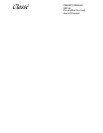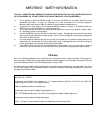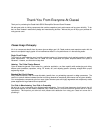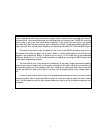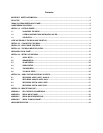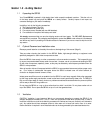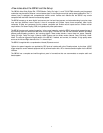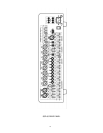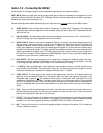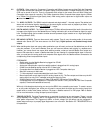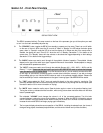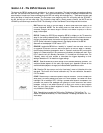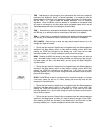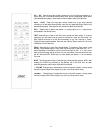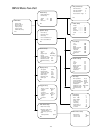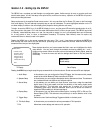
9
Section 2.0 - Connecting the SSP-60
Use the diagram on the previous page to follow the discussion regarding input and output connections.
SAFETY NOTE: Before you begin work we very strongly advise that all electronic equipment be unplugged from the AC
outlets or be switched off with the AC switch (NOT in Standby). Failure to follow the above advice can result in damage to
speakers and to electronics and perhaps to you.
RCA-style cables should be rotated (twisted) slightly as you insert them into (or remove them from) the SSP-60’s jacks.
2.1 VIDEO INPUTS: There are fifteen Video Inputs (3 Component, 6 S-Video and 6 Composite). The S-Video and
Composite video inputs are assigned to the like numbered analog (AV) audio inputs: VID1 is associated with AV1,
VID2 with AV2, etc.
2.1.1 DIGITAL INPUTS: The seven Digital Audio inputs may be assigned to any Audio source, (AV1 – AV6 and AUD1 –
AUD4). Any Digital input may be assigned to more than one source.
2.1.2 AUDIO INPUTS: When an audio source is selected for listening, the analog (if any) signal assigned to that input
will also appear at the record, record1, record2, and (if selected) at the remote zone outputs. Any Digital input
assigned to the same source will be heard at the Main 7.1 outputs only. When you have both a digital and an
analog input assigned to an audio source the analog signal will appear only at the three record outputs and (if
selected) at the remote zone output. The Digital signal will be processed and routed to the main outputs and also
appear unprocessed at the digital output. The analog signal going to the record-outs does not go through the A
to D and D to A converters. The two signals are handled separately. There is no way to send the processed digital
information to any of the record or remote zone outputs.
2.1.3 PLAY INPUTS: The PLAY input functions as part of a tape loop. It is designed to accept the output from a two-
channel tape machine. Pressing the TAPE button on the front panel routes the analog audio signal on the PLAY
input through the digital processor. Refer to Section 6 for more information on Taping.
2.1.4 7.1 INPUTS: These are analog audio inputs, designed to make it possible to listen to new multi-channel formats,
such as SACD and DVD-Audio. These inputs are analog only. The input signal goes only through the volume
control (still affected by your “speaker level” settings) and directly to the 7.1 Outputs.
2.1.5 VIDEO INPUTS: The three styles of video inputs are also separate from each other. A Composite video input
signal will not be converted to S-Video nor to Component video. An S-Video input signal will be present on the
Composite video outputs but not the Component video outputs. A Component video input signal will not be
converted to Composite nor to S-Video. If you want to send video to the remote zone output you have to feed the
SSP-60 a Composite video signal. Thus an S-Video signal can be sent to your television and to a recording VCR,
while only Composite video can be sent to the remote Zone. (S-Video should be sent only over a short length of
cable).
2.1.6 IR IN: There is one IR input which allows you to make a connection from the remote Zone area as well as from
the Main listening/viewing area. The Zone can be controlled from either the Main area or Zone and the Main
area can be controlled from either Main or the Zone area.
2.1.7 IR OUT: This output will permit you to control another piece of Classé equipment by repeating signals received
through the front panel IR receiver of the SSP-60. For this purpose, you will need to install a 2 conductor shielded
cable with 1/8” mini mono plugs at both ends from the SSP-60’s IR OUT to the IR in of the other unit.
2.1.8 MIC: This input will permit you to connect the supplied calibration microphone. See section 5.2.5 for details on
the auto calibration procedure.



